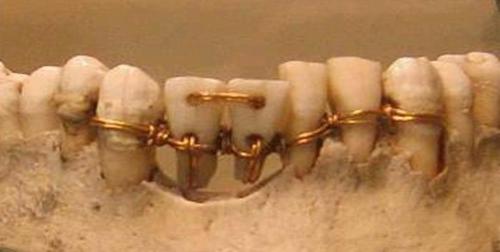
2025-04-18

Today, orthodontics may seem to be the most important and most modern part of the dentistry, but the “beautiful smile” is a project from ancient Egypt. The orthodontic gradually progressed through various devices and techniques to become such an advance that we are seeing today. The teeth and jaws are not intertwined, and the unevenness always reduces our ability to chew and speak from the very beginning of human existence. So it is not surprising that orthodontic history dates back thousands of years:
Ancient Orthodontics
In an American journal of orthodontics and orthopedics, archaeologists have found abnormal teeth from human remains, dating back to about 50,000 years ago, and at the time they were trying to sort their teeth using human components.
Today, the orthodontist doctor uses brackets to correct irregular teeth, which has found something very similar to those of modern brackets in Egyptian waxes. Many mummies have rough metal around their teeth, and archaeologists believe that ancient cat eggs may have been used in ancient Egypt. In this way, the intestines of the cat in the mouth are attached to the teeth to provide pressure to move the teeth.
In addition to the Egyptian people, the ancient Greeks, the Etruscan, and the Romans also performed orthodontic treatment. David Evans (a dentist’s surgeon) discovered golden gauzes that Etruscan women used to keep their teeth in place. As a result, the beauty and tidiness of the teeth have long been considered by all ethnic groups.
Ancient Greek physician, Hypocrites, wrote his first article, “Well-known Nonsmall Description and Dental Disorders,” about 400 BC. Many opinions about teeth and dental anomalies were considered. One of these views was expressed by a Roman writer about 400 years later. He recommended that you regularly push the new teeth with your fingers to return to their proper position.
Centuries 17 and 18
In the early 17th century, anger and depression caused by dental anomalies began to occur. Eventually, after the ancient era, progress in orthodontics was halted until the eighteenth century. Pierre Fachard, the father of dentistry, invented a tool called bandeau. This metal bar like a horseshoe contained holes that were regularly spaced apart and placed around the tooth to correct their displacement.
Orthodontics in the United States
Significant progress in orthodontics began in the United States in the nineteenth century. A type of header was invented that was attached to the head and neck and from the outside of the mouth to the jaw to apply gentle pressure on the teeth. Then in 1840, the first classic dental book called “Art of Dentistry” was published, which used techniques such as soldering on the strap to help tooth rotation. They also used golden sticks attached to tooth mills to open the toothpaste.
Entering the twentieth century
Without reference to the modern Orthodox father-in-law, Edward Hartley, the history of orthodontics will not be complete. A man with a range of achievements mentioned in the Advanced Dental Magazine. Eduard Hartley identified the main cause of malocclusion, inconsistency and disorientation in teeth, and in 1880, with a very effective set of orthodontic instruments.
Progress in the 1970s
Before the 1970s, orthodontists wound braces around each tooth by closing the wire around each tooth. The invention of a dental adhesive means that they can attach brackets to teeth surfaces instead of wire using adhesive. Meanwhile, because of the most popular choice for wire, stainless steel replaced gold and silver and significantly reduced orthodontic cost with brackets.
The lingual orthogonal or back braces behind the dentures inside the dental surfaces to address the aesthetic concerns still present are first introduced in the 1970s.
Many dental products are available today for orthodontic patients. Toothbrushes are available with different brands to use around the brackets so that they can help clean your teeth and hygiene effectively without damaging the wires and brackets.
As with ancient Egyptians, it’s clear that healthy teeth are very important.





Rate this article